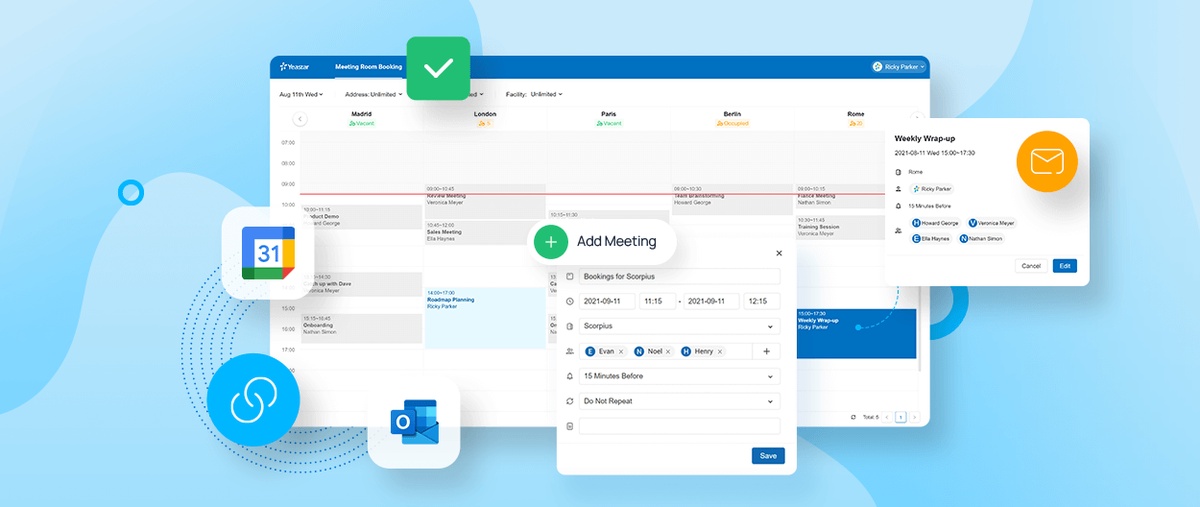In today's fast-paced world, effective facility management is crucial for businesses to maintain efficiency and productivity. One key aspect of facility management is room scheduling. Efficiently managing meeting rooms, conference halls, and other spaces within an organization can streamline operations and enhance collaboration among teams. To achieve this, businesses require robust room scheduling software, also known as room scheduler software, that meets their specific needs and enhances their overall productivity.
Understanding the Importance of Room Scheduling Software
Room scheduling software plays a pivotal role in modern facility management by providing organizations with the tools they need to effectively manage their spaces. Whether it's scheduling meetings, reserving conference rooms, or tracking resource utilization, a comprehensive room scheduling solution can streamline operations and improve resource allocation. By centralizing scheduling processes and providing real-time updates, such software minimizes conflicts and ensures that spaces are utilized optimally.
Key Features to Look for in Room Scheduling Software
When selecting room scheduling software for your organization, it's essential to consider several key features that can make a significant difference in your facility management processes. These features include:
-
Intuitive User Interface
An intuitive user interface is essential for ensuring widespread adoption of room scheduling software within an organization. Users should be able to quickly navigate the software, view room availability, and book spaces without encountering any difficulties. A clean and user-friendly interface enhances productivity and reduces the learning curve for new users.
- Customizable Booking Options
Every organization has unique scheduling requirements, and room scheduling software should offer customizable booking options to accommodate these needs. Whether it's setting recurring meetings, specifying resource requirements, or integrating with existing calendar systems, the ability to tailor booking options ensures that the software aligns seamlessly with your organization's workflows.
- Real-Time Updates and Notifications
Timely communication is essential for effective room scheduling, and software that provides real-time updates and notifications can prevent scheduling conflicts and facilitate smooth operations. Whether it's notifying users of room availability, sending reminders for upcoming meetings, or alerting administrators of conflicting bookings, real-time updates ensure that everyone stays informed and on track.
- Integration Capabilities
Room scheduling software should integrate seamlessly with other tools and systems used within the organization, such as calendar applications, email platforms, and facility management software. Integration capabilities streamline processes, eliminate duplicate data entry, and enhance overall efficiency by enabling seamless communication between different systems.
- Reporting and Analytics
To make informed decisions about resource allocation and utilization, organizations need access to comprehensive reporting and analytics tools. Room scheduling software that provides detailed insights into room usage, booking trends, and resource utilization empowers administrators to optimize space allocation and identify areas for improvement.
Implementing Room Scheduling Software for Maximum Efficiency
Once you've selected the right room scheduling software for your organization, the next step is implementing it effectively to maximize efficiency and productivity. Here are some tips for successful implementation:
-
Conduct Training Sessions
Provide comprehensive training sessions for employees to familiarize them with the features and functionality of the room scheduling software. Ensure that users understand how to book rooms, manage reservations, and utilize advanced features to streamline their workflows effectively.
-
Establish Clear Policies and Procedures
Establish clear policies and procedures for room scheduling to ensure consistency and prevent conflicts. Define rules for booking rooms, cancelling reservations, and resolving disputes to maintain order and accountability within the organization.
-
Regularly Review and Update Settings
Regularly review and update the settings and configurations of the room scheduling software to align with changing organizational needs. Periodically reassess user feedback, analyze usage patterns, and make adjustments as necessary to optimize the software for maximum efficiency.
-
Provide Ongoing Support
Offer ongoing support and assistance to users to address any issues or challenges they may encounter while using the room scheduling software. Whether it's troubleshooting technical issues, providing additional training, or addressing user feedback, proactive support ensures smooth operation and user satisfaction.
Conclusion
In conclusion, effective room scheduling software is essential for streamlining facility management processes and enhancing productivity within organizations. By selecting a solution with intuitive features, customizable options, real-time updates, integration capabilities, and robust reporting tools, businesses can optimize their space utilization and improve collaboration among teams. With proper implementation and ongoing support, room scheduling software can serve as a valuable asset in achieving organizational goals and maintaining operational efficiency.


No comments yet